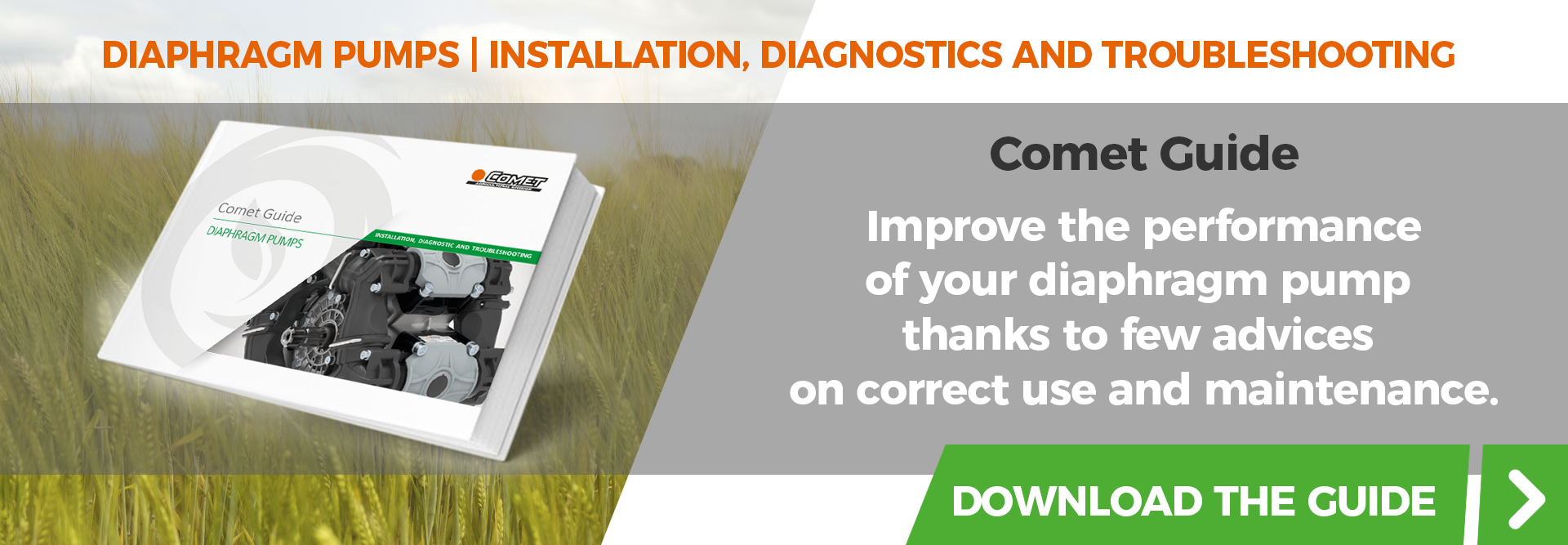The diaphragm pumps are basic tools in agriculture, and by following their cycles, they observe a rest period in winter. However, it is important to know well what to do before storing them during the winter season.
Boom sprayers, air blast sprayers and all other agricultural equipment employing diaphragm pumps generally get very little use during winter, so they are disassembled and stored until spring.
This is the time to carry out special maintenance operations specifically aimed at safeguarding diaphragm pumps from the damage that frost and low temperatures can cause during downtime.
Before we learn about these special operations, however, let's learn about general maintenance and how to remedy any problems with diaphragm pumps.
THE PROPER MAINTENANCE OF PUMPS
Basic steps should be taken before starting a system powered by a diaphragm pump, aimed at achieving the best operation of the system itself, ensuring the safety of operators and avoiding damage to the pump in the first place.
Important foreword: before performing any maintenance or disassembly work, drain and flush the pump with clean water.
First a general visual inspection should be made, especially to check the hydraulic system for signs of wear and clogging, then for every connection in the system to be tight and the pump securely attached to the frame.

Then the oil: the reference level should always be maintained, according to when indicated on the compensator glass and, in case of lack, top up. If you notice, then, that the color of oil becomes milky, you should immediately call in a technician at a service center for more thorough maintenance and possible repair or replacement of failed components.
After each use, the pump and the entire circuit should be flushed with clean water, paying special attention to rinsing the suction filter.
After every 300 hours or at the end of the season (whichever comes first), a new set of diaphragms should be installed, the valves inspected, and the oil changed.
READ ALSO: DIAPHRAGM PUMPS: TIPS FOR A CORRECT LIFE MAINTENANCE

HOW TO REMEDY PUMP PROBLEMS
If you carry out proper routine maintenance, the life cycle of your diaphragm pump can be extended and maximum performance can be obtained.
However, even perfectly maintained pumps may experience a sudden failure or breakdown. Knowing which problems you may be heading for is the first step in preventing irreparable consequences; a malfunctioning pump, in fact, may feature uneven pressure, deformation of some parts, excessive pulsation or sudden drops in oil level.
Once recognized, it is good to know how to promptly take action on abnormal diaphragm pump operations before we get to more serious damage.
We have already covered this topic extensively in a special article explaining how to take independent action to maintain your agricultural diaphragm pump at its best.
READ PROBLEMS OF A DIAPHRAGM PUMP: TROUBLESHOOTING
HOW TO STORE DIAPHRAGM PUMPS FOR WINTER
Before putting the pumps “to rest”, some standard operations should be performed, such as providing protection for the pump from dirt and dust during storage.
Even before that, as also recommended in the operation and maintenance manuals for machines that incorporate pumps, it is a good idea to perform a cleaning cycle after use, by having the pump draw clean water. In fact, it is very important never to leave the pumped liquid inside the pump before putting it to rest.
More important than cleaning, however, is safety: any cleaning work must be carried out under conditions of safe stability, with no moving parts, no pipes full of pressurized liquid and when cooling is complete.
Especially remember to always disconnect the power supply from the power source. Also, do not use thinners or solvents for cleaning.

Special jobs should be carried out in areas with a very harsh climate before winter storage: diaphragm pumps can’t withstand frost, so in order to avoid ice formation inside, it is advisable to have the pump suck an automotive antifreeze product (with the dilutions provided for the minimum temperatures to which the pump will be exposed) and then proceed to completely empty the manifolds, running it for a few minutes without suctioning any liquid.
Any antifreeze liquid used to protect the pump from freezing must, then, be properly disposed of and not improperly dispersed into the environment.
Failure to follow these simple prescriptions can result in serious damage to the pump. Likewise, therefore, do not operate the pump in the presence of ice.













